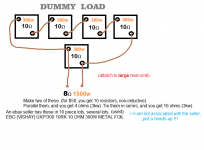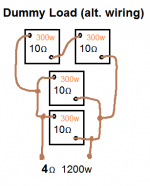Car battery testers are carbon pile, right? But they all seem to be a fraction of an ohm.
Yes they are. Maybe not the best when you need a higher resistance, but when you want to soak big amps they are a cheap option.
These would also do well for a big resistive load, on a heatsink of course.
TEH100 Series Resistors - Ohmite | DigiKey
TEH100 Series Resistors - Ohmite | DigiKey
And I just tripped over this on eBay.
Audio Power Amp Amplifier Dummy Test Load 8 Ohm 300W | eBay
Now that's a big resistor!
Audio Power Amp Amplifier Dummy Test Load 8 Ohm 300W | eBay
Now that's a big resistor!
And I just tripped over this on eBay.
Audio Power Amp Amplifier Dummy Test Load 8 Ohm 300W | eBay
Now that's a big resistor!
Indeed it is.
Also found a 500w variant
500 Watts 8 Ohm High Power Ceramic Tube Resistor Wirewound Coated 500W | eBay
I got 12 of these. 10 EBG Ultra High Power Resistors UXP 300 | eBay
and one of these http://www.ebay.com/itm/141353207339?_trksid=p2059210.m2749.l2649&ssPageName=STRK:MEBIDX:IT
and one of these http://www.ebay.com/itm/141353207339?_trksid=p2059210.m2749.l2649&ssPageName=STRK:MEBIDX:IT
Last edited:
I kind of like this packaging idea, no high-current switches needed. But, I'd like it mounted in a strong box that could sit on the floor or bench or speaker cab, and possibly have one big footswitch...and a vertical heat sink. And able to take 1000+ watts and cost about 1/3 of that outrageous price.
Koch Loadbox LB120II 4 Ohm Guitar Amp Power Attenuator | eBay
Koch Loadbox LB120II 4 Ohm Guitar Amp Power Attenuator | eBay
Last edited:
With the resistors capable of far in excess of what I'll put thru them their value will be pretty constant for measurement purposes. For playing guitar attenuated though, I might want some adjustable filters and if the resistance increases with crummier resistors when hot, well it will decrease the load on the amp when it's also hot, maybe that's why some people like lightbulbs in their power soak, but it also makes the speaker quieter as things heat up.
The attenuators which use transformers (like the Marshall Power Brake) are interesting, but I'm not sure I fully understand the intent. They are somewhat inductive, and so are the speakers they emulate...the 'soak's' transformer is probably easy for the amp's transformer to drive, with a certain attractive symmetry about it, unless the inductance gets ridiculous and some connection becomes intermittent and the back voltage gets out of hand and arcing around. So the big advantage is that you can use all of just one big power resistor, and vary the attenuation and load on the amp via different taps on the transformer, or something like that (instead of normal soaks which are not even using many of the resistors inside on some settings)??? But the transformer is more expensive than a handful of power resistors (or is the because I get the resistors surplus). Some claim that pure resistance loads affect the amp's tone detrimentally??? I'm not sure I understand. I'm not sure I understand the transformer in the Fostex attenuator that has one; it costs about 8 times more than their similarly-rated simple L-Pad. What's the advantage?
I got 12 of these. 10 EBG Ultra High Power Resistors UXP 300 | eBay
Same seller maybe.....they are on Ebay in 10-piece lots.
Qty 10 EBG Vishay UXP 300 10RK 10 Ohm 300W Metal Foil Non Ind Power Resistor | eBay
I just bought a lot of 10 ($50).
EBG UXP 300 (data sheet)
Here is what I will try, when they arrive.....
Attachments
Last edited:
Neither work as you have shown.
The 10r 300W can take upto 54.77V, either DC or AC.
I don't know if that is continuous, or intermittent.
10r||40r gives you 8r. The 40r needs to be able to withstand the same voltage as on the 10r, i.e. 54.77V The 40r needs a 75W rating to match the same voltage as the 10r.
The total rating for the 8r will then be 375W. increasing the power rating of the 40r does NOT increase the power rating of the whole assembly, the 10r 300W rating determines the maximum voltage that can be applied.
If you use 43r 70W, then you get 8r113.
You can trim this down, until all of your loads match.
Theoretically 573r 5.2W brings the 10r||43r down to 8r0, but you can use any of the E24 series around that value.
Notice that the 70W + the 5.2W of the parallel combination 43r||573r add up to that 75W.
Lots of 8r dummy loads become very useful.
Giving 5r33, 4r0, 2r67, 2r0, 1r6
The 10r 300W can take upto 54.77V, either DC or AC.
I don't know if that is continuous, or intermittent.
10r||40r gives you 8r. The 40r needs to be able to withstand the same voltage as on the 10r, i.e. 54.77V The 40r needs a 75W rating to match the same voltage as the 10r.
The total rating for the 8r will then be 375W. increasing the power rating of the 40r does NOT increase the power rating of the whole assembly, the 10r 300W rating determines the maximum voltage that can be applied.
If you use 43r 70W, then you get 8r113.
You can trim this down, until all of your loads match.
Theoretically 573r 5.2W brings the 10r||43r down to 8r0, but you can use any of the E24 series around that value.
Notice that the 70W + the 5.2W of the parallel combination 43r||573r add up to that 75W.
Lots of 8r dummy loads become very useful.
Giving 5r33, 4r0, 2r67, 2r0, 1r6
Last edited:
Try two 3500 Watt / 240 Volt hot water heating elements in parallel. Get a 5 gallon bucket with a sealing lid and install the elements through the lid. Fill with a [small] bleach and water mix or mineral oil and create a vent hole. Good luck overheating that.
I use the above with 4 elements to create two 8 ohm loads that can be paralleled for 4 ohms. They measure 8.2 ohms each. I also have two smaller separate 8 ohm non-inductive load resistors that are good to about 100 watts each on a heat sink with fans.
For those of you in the USA, Lowes has 3500 Watt / 240 Volt elements for $9.00 each. Buckets are also there. Get yourself a 1.5 inch speed bit, some RTV (or silicone) sealant and some lamp cord. You will be all set for an easy afternoon project.
I use the above with 4 elements to create two 8 ohm loads that can be paralleled for 4 ohms. They measure 8.2 ohms each. I also have two smaller separate 8 ohm non-inductive load resistors that are good to about 100 watts each on a heat sink with fans.
For those of you in the USA, Lowes has 3500 Watt / 240 Volt elements for $9.00 each. Buckets are also there. Get yourself a 1.5 inch speed bit, some RTV (or silicone) sealant and some lamp cord. You will be all set for an easy afternoon project.
Ohm's law still applies.You are correct Andrew.
In haste, I neglected most Ohm's Laws and parallel/series resistive rules.
My 3am in-the-morning brilliant idea should have waited a day or-so for me to think it through.
The parallel resistors rule still applies.
It was the summing of the Power Rating that went astray.
- Status
- This old topic is closed. If you want to reopen this topic, contact a moderator using the "Report Post" button.
- Home
- Design & Build
- Equipment & Tools
- Power Soaks and Dummy Loads


